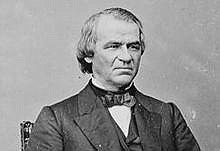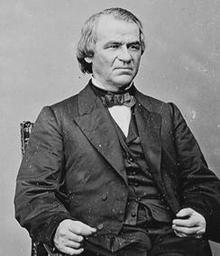The tug of war between Gov. Bill Lee's office and state legislative leaders over the bust of Confederate Gen. Nathan Bedford Forrest in the state Capitol building brings to mind the treatment of statuary in the same building of a former president of the United States.
Andrew Johnson, the Tennessean who acceded to the nation's top office upon the 1865 assassination of President Abraham Lincoln, found no love in the Capitol building until 1979, 104 years after his death.
Tennessee's other two presidents, Andrew Jackson and James K. Polk, already were well represented there. An outdoor statue of Jackson was erected during the 19th century, and at least three busts of the seventh president were created in the 20th century. Polk is buried on the Capitol grounds, and a bust of him was created in 1961.
But Johnson? Well, it's complicated.
A 1979 Associated Press article intimates the 17th president, a Democrat, was shunned by his Democratic brethren, who had long dominated the Tennessee legislature, because of his association with the, uh, War of Northern Aggression.
Johnson, in the throes of the Civil War, had been picked by Lincoln, a Republican, as his running mate in 1864.
"Bitterness over the war, in which East Tennessee was loyal to the Union and the rest of the state to the Confederacy, has a great deal to do with the tardiness in recognizing Johnson," the AP wrote.
So it took a Republican, state Rep. Joe Bewley of Greeneville, to get the job done.
In 1977, he sought and obtained a $20,000 appropriation from the legislature to pay for the bronze bust, and it was created from pictures of Johnson in the Library of Congress by William Behrends, then sculptor-in-residence at Randolph-Macon College in Lynchburg, Virginia.
The one-and-a-half times life-size work at the time was placed in a marble cubicle alongside busts of Jackson and Polk on the second floor of the Capitol.
While Johnson's children and his children's children didn't live to see him honored in Nashville, at least one of his great-granddaughters did.
Stooped and in her 80s, according to the AP account, Margaret Patterson Bartlett was joined for the unveiling ceremony by Republican Tennessee Gov. Lamar Alexander, Republican state Senate leader Tom Garland of Greeneville, former Republican state House speaker Bill Jenkins of nearby Rogersville (the only member of the GOP to hold that office at the time), and Bewley.
"I greatly appreciate this honor," she said.
Johnson was one of the first governors to occupy the state Capitol, where his bust now sits, and he also was a U.S. senator before being selected by Lincoln. In addition, he is the only president to be elected to the Senate after he served in the White House.
He also was the first president ever impeached, saving his job by one vote but was unwelcome by Northerners because of his softness toward the South during Reconstruction and unloved by Southerners because of his association with Lincoln.
A statue of Johnson on the lawn of the Capitol was erected in 1995.
If one believes today's squabbling over the Forrest bust is an outgrowth of the 2020 protests following the death of Minneapolis suspect George Floyd in police hands, they should think again.
In March, the Tennessee Historical Commission voted 25-1 that the bust be relocated to the state museum over - according to Lee - the "pain, suffering and brutal crimes against African Americans" it represents. However, Lt. Gov. Randy McNally and House Speaker Cameron Sexton, armed with a legal opinion from state Attorney General Herbert Slatery, believe it first should have been considered by the State Building Commission, which Lee bypassed and which could decide the bust can stay.
Time will tell - the state should know by mid-summer - who wins the argument.
But in the same 1979 Chattanooga News-Free Press edition that contained the account of the Johnson statue being unveiled, another article noted that a group of Black Tennesseans had met with Alexander over the Forrest bust, which had only been in place since 1978. A second group had tried without success to meet with Nashville Mayor Richard Fulton.
The Black groups' efforts were countered by three recent cross burnings in the state by a splinter group of the Ku Klux Klan, which Forrest had helped start.
"We're not going to have them out protesting without us also protesting," said T.J. Wiley, who identified himself as the Tennessee grand dragon of the National Knights of the Ku Klux Klan. "A burning cross is a symbol of protest on our behalf. We may have more if this continues. We may move on statues of some of their leaders."
Fortunately, we don't hear from KKK grand dragons anymore. The Forrest argument, meanwhile, has continued for another 40-plus years. And Johnson? Safe and secure at the Capitol, he now has company among the impeached president ranks.

